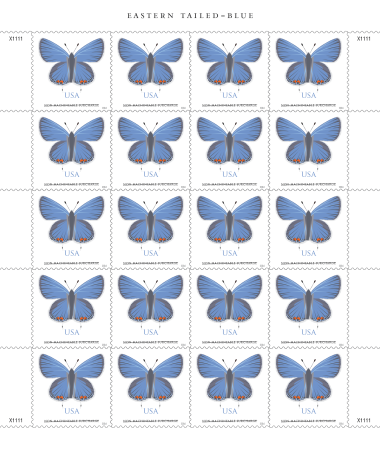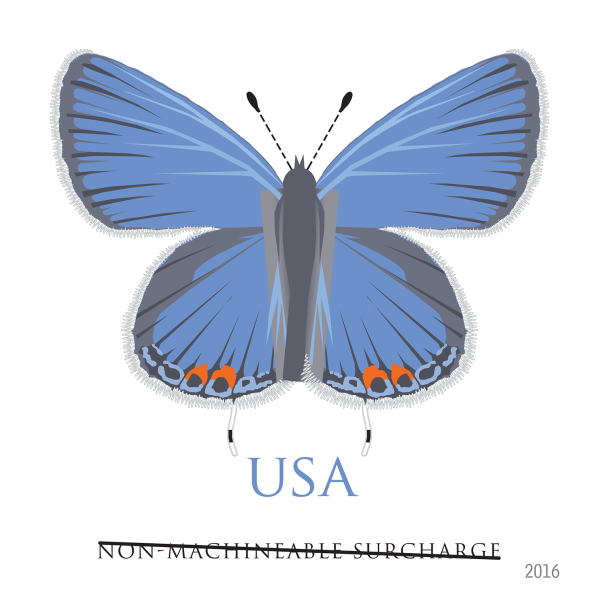
About This Stamp
The Eastern tailed-blue butterfly graces the sixth non-machineable butterfly stamp for use on irregularly sized envelopes, such as square greeting cards, invitations, or announcements.
The stamp art was created on a computer, using images of preserved butterflies as a starting point. The result is a highly stylized, simplified image of an Eastern tailed-blue rather than an exact replica.
The Eastern tailed-blue butterfly (Cupido comyntas) is named for its iridescent blue color of the upper wing surface, more vivid in the male, and for the short, thread-like tail on each hind wing. Females are often slate grey, sometimes with vivid blue close to the body. Each year sees two or more generations, the latter being less colorful. This 2016 stamp depicts a first generation male, which displays the species’ brightest coloration.
Common east of the Rocky Mountains and in parts of the West, the Eastern tailed-blue butterfly's range also extends into Mexico, Central America, and southern Canada. This inch-wide butterfly thrives in sunny spots where vegetation is low to the ground, including meadows, forest clearings, vacant lots, and mown roadside grasses.
The square format of the stamp was developed in partnership with the greeting card industry specifically for oversized or square envelopes. These envelopes cannot pass through the automated Postal processing system and have to be hand-cancelled. They are charged a non-machineable surcharge even if they weigh less than one ounce. Greeting card envelopes printed with a silhouette of a butterfly indicate the need for additional postage—or the use of a butterfly stamp. Any non-machineable envelope, like oddly-shaped or vertical envelopes, as well as lumpy envelopes, rigid envelopes, or mail with clasps, ribbons, or buttons, may use this stamp.
Eastern Tailed-Blue is available in sheets of twenty. The words “NON-MACHINEABLE SURCHARGE” on the stamp indicate its usage value. Like a Forever® stamp, this stamp will always be valid for the rate printed on it.
Nationally known artist Tom Engeman created the stamp art. Art director Derry Noyes designed the stamp.
Stamp Art Director, Designer, and Typographer

Derry Noyes
For more than 40 years Derry Noyes has designed and provided art direction for close to 800 United States postage stamps and stamp products. She holds a bachelor of arts degree from Hampshire College and a master of fine arts degree from Yale University.
Noyes worked as a graphics designer at Beveridge and Associates, a Washington, D.C., firm, until 1979 when she established her own design firm, Derry Noyes Graphics. Her clients have included museums, corporations, foundations, and architectural and educational institutions. Her work has been honored by American Illustration, the Art Directors Club of Metropolitan Washington, Communication Arts, Critique magazine, Graphis, Creativity International, and the Society of Illustrators.
Before becoming an art director for the U.S. Postal Service, she served as a member of the Citizens' Stamp Advisory Committee from 1981 to 1983.
Noyes is a resident of Washington, D.C.
Stamp Artist

Tom Engeman
Nationally acclaimed artist Tom Engeman, a resident of Kensington, Maryland, is well known for his poster and stamp designs. The winner of numerous design awards, he lists among his career accomplishments being the first art director for Washingtonian magazine, designing Historic Preservation magazine, and creating posters for the Metro, Washington’s new subway system, which were stolen as soon as they went up.
Among his many designs for the U.S. Postal Service are the Liberty Bell Forever® stamp, 60 stamps for the Flags of Our Nation series that began in 2008, and eight butterfly-themed stamps, the first issued in 2010, intended for use on large greeting card envelopes and other mail of nonstandard shapes and sizes. Engeman's most recent butterfly stamp design is Colorado Hairstreak (2021).
